中国文化概况(修订版)Chapter 7
中国文化概况第六、七章和结语笔记
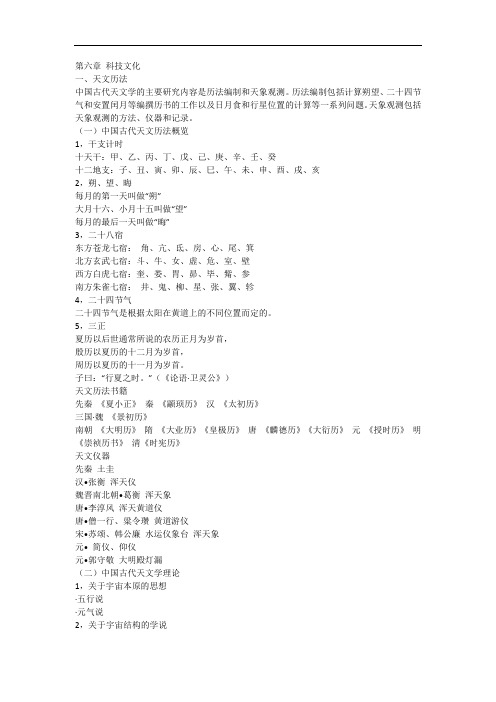
第六章科技文化一、天文历法中国古代天文学的主要研究内容是历法编制和天象观测。
历法编制包括计算朔望、二十四节气和安置闰月等编撰历书的工作以及日月食和行星位置的计算等一系列问题。
天象观测包括天象观测的方法、仪器和记录。
(一)中国古代天文历法概览1,干支计时十天干:甲、乙、丙、丁、戊、己、庚、辛、壬、癸十二地支:子、丑、寅、卯、辰、巳、午、未、申、酉、戌、亥2,朔、望、晦每月的第一天叫做“朔”大月十六、小月十五叫做“望”每月的最后一天叫做“晦”3,二十八宿东方苍龙七宿:角、亢、氐、房、心、尾、箕北方玄武七宿:斗、牛、女、虚、危、室、壁西方白虎七宿:奎、娄、胃、昴、毕、觜、参南方朱雀七宿:井、鬼、柳、星、张、翼、轸4,二十四节气二十四节气是根据太阳在黄道上的不同位置而定的。
5,三正夏历以后世通常所说的农历正月为岁首,殷历以夏历的十二月为岁首,周历以夏历的十一月为岁首。
子曰:“行夏之时。
”(《论语·卫灵公》)天文历法书籍先秦《夏小正》秦《颛顼历》汉《太初历》三国·魏《景初历》南朝《大明历》隋《大业历》《皇极历》唐《麟德历》《大衍历》元《授时历》明《崇祯历书》清《时宪历》天文仪器先秦土圭汉•张衡浑天仪魏晋南北朝•葛衡浑天象唐•李淳风浑天黄道仪唐•僧一行、粱令瓒黄道游仪宋•苏颂、韩公廉水运仪象台浑天象元• 简仪、仰仪元•郭守敬大明殿灯漏(二)中国古代天文学理论1,关于宇宙本原的思想·五行说·元气说2,关于宇宙结构的学说盖天说浑天说宣夜说3,关于宇宙无限性的辩证论述宇:空间宙:时间(三)中国古代天文学的特征1,中国古代的天象记录是当时世界上最丰富,最有系统的。
日食月食、日珥、流星雨、哈雷彗星、太阳黑子、新星(客星)、超新星、蟹状星云、行星、恒星……2、历法的编纂带动天文学的发展,以阴阳合历为传统,并与农业关系密切。
3,中国古代天文学明显的官办色彩,与占星术密切相关。
二、传统医学(一)中国传统医药概览1,砭石与灸法砭石是原始人类最初使用的医疗工具灸法产生于火的发现和使用之后。
中华文化概况 7
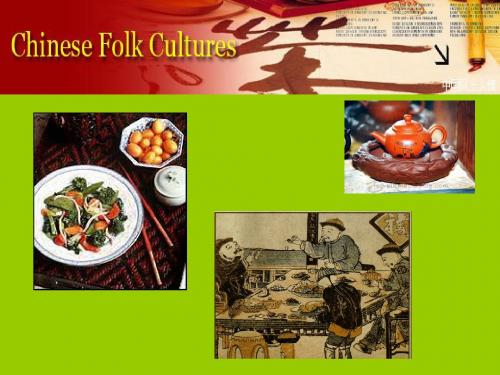
Chinese Chopsticks
• In remote ages----branches, bamboo or natural animal bones. • Later-- scraped bamboo or wood • during the Xia and Shang dynasties-- Ivory and jade chopsticks appeared • during the Spring and Autumn Period-- bronze and iron chopsticks emerged • the Han Dynasty-- Laquer chopsticks appeared • Later-- silver and gold chopsticks were made • the ones made with rhinoceros horns, jade or ebony inlaid with gold were the rarest
Chinese Chopsticks
Chinese Chopsticks
• a wonder of Chinese dining utensils--- a food picking utensil made of bamboo or wood, is widely used by the Hans and some minority ethnic groups. • a history of thousands of years • In ancient China, they were called zhu • fully displayed the dexterity and intelligence of the Chinese people
中国文化概况
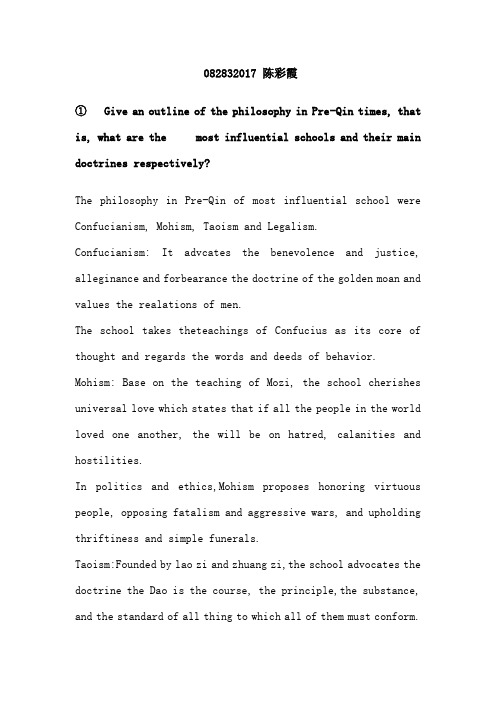
082832017 陈彩霞① Give an outline of the philosophy in Pre-Qin times, that is, what are the most influential schools and their main doctrines respectively?The philosophy in Pre-Qin of most influential school were Confucianism, Mohism, Taoism and Legalism.Confucianism: It advcates the benevolence and justice, alleginance and forbearance the doctrine of the golden moan and values the realations of men.The school takes theteachings of Confucius as its core of thought and regards the words and deeds of behavior. Mohism: Base on the teaching of Mozi, the school cherishes universal love which states that if all the people in the world loved one another, the will be on hatred, calanities and hostilities.In politics and ethics,Mohism proposes honoring virtuous people, opposing fatalism and aggressive wars, and upholding thriftiness and simple funerals.Taoism:Founded by lao zi and zhuang zi,the school advocates the doctrine the Dao is the course, the principle,the substance, and the standard of all thing to which all of them must conform.Legalism: Legalism, begun by Hanfeizi, espouses laying down laws to unify the thought of people, promoting agriculture to achie ve affluence, waging wara to gain strength andpower.Stress on spiritual existence, stress on practice, stress onmorality, stress on harmony, stress on intuition.② What Features of Chinese Food are emphasized generally? Among the Chinese “Eight Regional Cuisines”, which one do you like most? Why?The Features of Chinese Food are color ,aroma,taste. Color refers not only to the beautiful color of the food, but also to the layout and design. Aroma refers to the fragrant and appetising smell of the dishes, served on the table before eating. Taste is not only associated with tasting the food itself ,but also with the approciation of seasing and texture. Among the Chinese “Eight Regional Cuisines”, I like Zhejiang Cuisine most.Because Zhejiang cuisine has a bright, delicious Huanen, crisp refreshing soft, small and exquisite cuisine, Kiyotoshi beautiful features. It stewed, fried, braised, steamed known for heavy authentic. Zhejiang cuisine features : First, fine finish, taking materials to make dishes to elegant fine part of the superior. Second, withspecialty dishes obvious local characteristics.Third, the emphasis on fresh, pure taste dishes. Fourth, the pursuit of fresh, crisp, refreshing dishes.③ Please describe briefly the Origin of Chinese Double Seven festival.Chinese Double Seven festivalfirst comes from the people of nature worship. From historical documents, at least, three thousand years ago, as people's understanding of astronomy and the generation of textile technology. People far more than the worship of the stars is Altair and Vega, they think things have seven representatives of North-South orientation of the stars, collectively known as Ershibasu, the brightest of which the Big Dipper, to identify the direction for the night.The Legend of Chinese Double Seven festival:Niulang’s parents died young, and has often been Gesao abuse, accompanied by only one ox. One day a cow gave him a trick, to marry a wife Weaver. By then, people have turned to a beautiful fairy Galaxy bathing, and playing in the water. Then hidden in the reeds suddenly ran out of the Cowherd and Weaver took the clothes. Panic-stricken maidens, dressed hurriedly ashore clothes flew off, Weaver left alone. In the Legend of the plea, the Weaver promised to do hiswife. Weaver, and Weaver married thing was heaven, the Jade Emperor, and the Queen Mother knew, they rage, and ordered the lower bound gods recaptured Weaver. Cowboy god while not at home when captured Weaver. Seeing that we should catch up, the Queen Mother a heart emergency, unplug the head Jinzan a plan to the Galaxy, the Milky Way Yisha between old clean and shallow turbid waves become monstrous, never make life difficult for a Cowboy. Since then, Legend of Love can only tears Ying Ying, across the river, forever, the Jade Emperor and the Queen Mother also fail to beat the sincere feelings between them, allowing them to meet once every year on July 7, according to legend, every seventh day in July, would human magpie fly overhead, and go ride in the Milky Way for the Legend of Love Magpie Bridge meet.④ China has had 33 sites added to the World Heritage List by UNESCO,please list as many as you know so far. While being proud of our ancient civilization, we still worry about the overexploitation of some heritage sites. Please give some good suggestions to deal with possible problems.1.China2.Imperial Palaces of the Ming and Qing Dynasties in Beijing and Shenyang3.Mausoleum of the First Qin Emperor4.Mogao Caves5.Mount Taishan6.Peking Man Site atZhoukoudian 7.The Great Wall 8.Mount Huangshan9.Huanglong Scenic and Historic Interest Area10.Jiuzhaigou Valley Scenic and Historic Interest Area11.Wulingyuan Scenic and Historic Interest Area12.Ancient Building Complex in the Wudang Mountains13.Historic Ensemble of the Potala Palace, Lhasa 714.Mountain Resort and its Outlying Temples, Chengde15.Temple and Cemetery of Confucius and the Kong Family Mansion in Qufu 16.Lushan National Park17.Mount Emei Scenic Area, including Leshan Giant Buddha Scenic Area 18.Ancient City of Ping Yao 19.Classical Gardens of Suzhou 20.Old Town of Lijiang21.Summer Palace, an Imperial Garden in Beijing22.Temple of Heaven: an Imperial Sacrificial Altar in Beijing23.Dazu Rock Carvings 24.Mount Wuyi25.Ancient Villages in Southern Anhui – Xidi and Hongcun26.Imperial Tombs of the Ming and Qing Dynasties27.Longmen Grottoes 28.Mount Qingcheng and the Dujiangyan Irrigation System 29.Yungang Grottoes30.Three Parallel Rivers of Yunnan Protected Areas31.Capital Cities and Tombs of the Ancient Koguryo Kingdom32.Historic Centre of Macao33.Sichua n Giant Panda Sanctuaries - Wolong, Mt Siguniang and Jiajin MountainsMy suggestions: China should focus on the following lines to class or category of cultural heritage cultural heritage line: 〈1〉 As a priority, and immediately start the Silk Road and a handful of representative, the study has shown outsdanding value of the overall production of the cultural line, pre-registration and key sections of the world heritage application feasibility studies. In particular, the Grand Canal, in the context of the South project, its overall protection, whether from the perspective of cultural heritage or landscape ecology from the point of view, are imminent. 〈2〉Focus on the cultural significance and ecological values are more prominent in the regional cultural heritage corridor line or the integrity protection, such as the Yangtze River, Yellow River and other important cultural heritage of dense, prominent part of the section of cultural significance; through these Heritage Corridor building, forming the backbone of a regional network of green channel. 〈3〉 Protection of important cultural significance of some local cultural lines. Encourage the building of local ecological and cultural values of both the Heritage Corridor.。
A Glimpse of Chinese Culture《中国文化概论》讲义-chapters 1-8
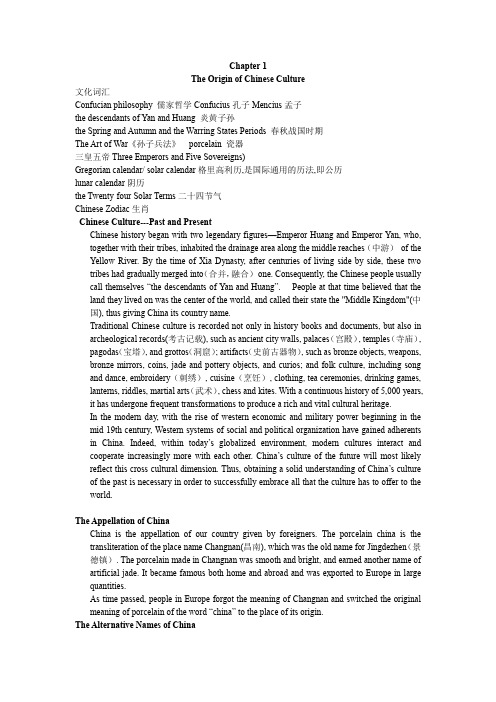
Chapter 1The Origin of Chinese Culture文化词汇Confucian philosophy 儒家哲学Confucius孔子Mencius孟子the descendants of Yan and Huang 炎黄子孙the Spring and Autumn and the Warring States Periods 春秋战国时期The Art of War《孙子兵法》porcelain 瓷器三皇五帝Three Emperors and Five Sovereigns)Gregorian calendar/ solar calendar格里高利历,是国际通用的历法,即公历lunar calendar阴历the Twenty-four Solar Terms二十四节气Chinese Zodiac生肖Chinese Culture---Past and PresentChinese history began with two legendary figures—Emperor Huang and Emperor Yan, who, together with their tribes, inhabited the drainage area along the middle reaches(中游)of the Yellow River. By the time of Xia Dynasty, after centuries of living side by side, these two tribes had gradually merged into(合并,融合)one. Consequently, the Chinese people usually call themselves “the descendants of Yan and Huang”.People at that time believed that the land they lived on was the center of the world, and called their state the "Middle Kingdom"(中国), thus giving China its country name.Traditional Chinese culture is recorded not only in history books and documents, but also in archeological records(考古记载), such as ancient city walls, palaces(宫殿), temples(寺庙), pagodas(宝塔), and grottos(洞窟); artifacts(史前古器物), such as bronze objects, weapons, bronze mirrors, coins, jade and pottery objects, and curios; and folk culture, including song and dance, embroidery(刺绣), cuisine(烹饪), clothing, tea ceremonies, drinking games, lanterns, riddles, martial arts(武术), chess and kites. With a continuous history of 5,000 years, it has undergone frequent transformations to produce a rich and vital cultural heritage.In the modern day, with the rise of western economic and military power beginning in the mid-19th century, Western systems of social and political organization have gained adherents in China. Indeed, within today’s globalized environment, modern cultures interact and cooperate increasingly more with each other. China’s culture of the future will most likely reflect this cross-cultural dimension. Thus, obtaining a solid understanding of China’s culture of the past is necessary in order to successfully embrace all that the culture has to offer to the world.The Appellation of ChinaChina is the appellation of our country given by foreigners. The porcelain china is the transliteration of the place name Changnan(昌南), which was the old name for Jingdezhen(景德镇). The porcelain made in Changnan was smooth and bright, and earned another name of artificial jade. It became famous both home and abroad and was exported to Europe in large quantities.As time passed, people in Europe forgot the meaning of Changnan and switched the original meaning of porcelain of the word “china” to the place of its origin.The Alternative Names of China⏹Chixian, Shenzhou(赤县、神州)⏹Jiuzhou (九州)⏹Hua ( 华)⏹Huaxia(华夏)⏹Zhonghua(中华)⏹Hainei(海内)Chinese MythologyChinese Mythology is a collection of cultural history, folktales(民间故事), and religions that have been passed down in oral or written form. Chinese mythology is similar to modern religion in that they both believe in relationships between mankind and a higher power.Historians have conjectured(推测)that Chinese mythology began in 12th century BC (close to the time of the Trojan War 特洛伊战争). The myths and legends were passed down in oral form for over a thousand years, before being written down in early book such as Shui Jing Zhu and Shan Hai Jing.The classification of myth神话的分类Creation myth 创世神话:Nvwa Created Man(女娲造人)Hero myth 英雄神话:Houyi Shooting the Sun(后羿射日)War myth 战争神话:Yellow Emperor Tackled Human-God(黄帝擒蚩尤)Cultural MosaicHeavenly Stems and Earthly BranchesThe standard Gregorian calendar is generally referred to as the solar calendar in China. The traditional Chinese lunar calendar, also known as the Jiazi calendar, counts the years in sixty-year cycles by combining two series of numbers---the 10 Heavenly Stems and 12 Earthly Branches.The Twenty-four Solar TermsThe traditional Chinese lunar year is divided into twenty-four solar terms, according to the position of the sun on the ecliptic in relationship to the earth. The solar terms designate agricultural periods, and can predict changing seasonal conditions, temperature, and weather throughout the course of the year. They are extremely important to agricultural production.Changes in the four seasons are determined by eight solar terms:立春( the Beginning of Spring),春分( the Spring Equinox ),立夏(the Beginning of Summer ),夏至(the Summer Solstice),立秋(the Beginning of Autumn),秋分( the Autumnal Equinox),立冬( the Beginning of Winter),冬至(the Winter Solstice )Changes in temperature are indicated by five solar terms:小暑Slight Heat ,大暑Great Heat ,处暑the Limit of Heat ,小寒Slight Cold ,大寒Great ColdChanging weather conditions are indicated by seven solar terms:雨水Rain Water ,谷雨Grain Rain ,白露White Dew ,寒露Cold Dew,霜降Frost's Descent ,小雪Slight Snow ,大雪Great Snow .Recurring natural phenomena are indicated by four solar terms:惊蛰the Waking of Insects ,清明Pure Brightness ,小满Grain Full,芒种Grain in EarChinese ZodiacIn ancient times, our ancestors counted the years with 10 heavenly stems and 12 earthly branches. Although this was scientific, most people were illiterate and could not memorize or calculate easily. Thus the animals that influenced people's lives were chosen to symbolize the terrestrial branches: the rat, ox, tiger, rabbit, dragon, snake, horse, sheep, monkey , rooster, dog and pig.Chapter 2 Culinary Culture文化词汇culinary厨房的,烹饪的;烹调用的cuisine烹饪,烹调法;菜肴main food主食,主粮(staple food )Fire temperature火候food tonic 食补“Food is the first necessity of the people”(“民以食为天。
中国文化概况
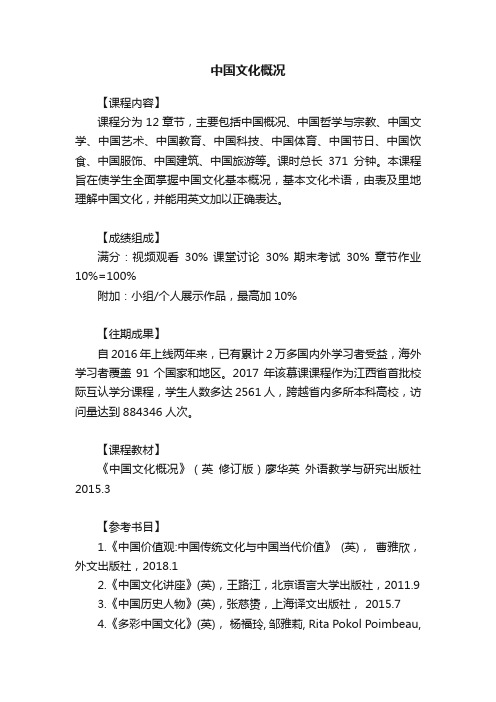
中国文化概况
【课程内容】
课程分为12章节,主要包括中国概况、中国哲学与宗教、中国文学、中国艺术、中国教育、中国科技、中国体育、中国节日、中国饮食、中国服饰、中国建筑、中国旅游等。
课时总长371分钟。
本课程旨在使学生全面掌握中国文化基本概况,基本文化术语,由表及里地理解中国文化,并能用英文加以正确表达。
【成绩组成】
满分:视频观看30% 课堂讨论30% 期末考试30% 章节作业10%=100%
附加:小组/个人展示作品,最高加10%
【往期成果】
自2016年上线两年来,已有累计2万多国内外学习者受益,海外学习者覆盖91个国家和地区。
2017年该慕课课程作为江西省首批校际互认学分课程,学生人数多达2561人,跨越省内多所本科高校,访问量达到884346人次。
【课程教材】
《中国文化概况》(英修订版)廖华英外语教学与研究出版社2015.3
【参考书目】
1.《中国价值观:中国传统文化与中国当代价值》(英),曹雅欣,外文出版社,2018.1
2.《中国文化讲座》(英),王路江,北京语言大学出版社,2011.9
3.《中国历史人物》(英),张慈赟,上海译文出版社, 2015.7
4.《多彩中国文化》(英),杨福玲, 邹雅莉, Rita Pokol Poimbeau,
天津大学出版社,2014.6
5.《中国文化概要》(英),任增强,北京大学出版社,2018.5。
文化概论第七章-精选文档
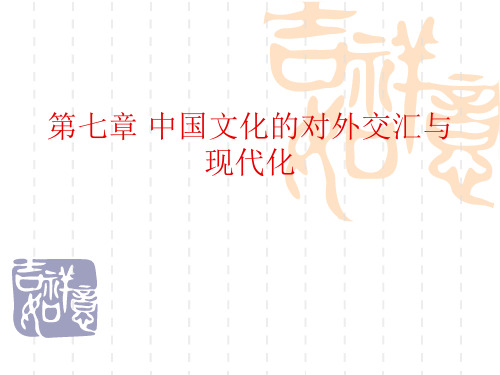
二、中国文化的第二次大交汇 中国文化的第二次大交汇开端于16世纪末。 即明代嘉靖、万历年间。 第二次文化大交汇的特点有哪些?(P332)
第一,交汇对象起了变化,不再是过去相对落后 于中国本土文化的西域草原文化与南亚次大陆文 化,而是整体水平超过中国的西方欧洲文化,后 来还有美国、日本文化。 第二,交汇兴趣起了变化,中国人对外来宗教表 示出莫大的冷淡,而对天文、数学、舆地、水利、 火器等科学知识兴趣十足,致使西方不得不采取 迂回策略。 第三,交汇时间长,从16世纪末叶开始以绵延四 个世纪,至尽仍在继续进行之中。 第四,交流反差大,西方文化对中国社会和中国 文化系统造成了强烈的震撼。
第七章 中国文Leabharlann 的对外交汇与 现代化 文化具有时代性和民族性。 中国文化从来是不封闭的排他的文化体系,在中 国文化与世界文化的交汇中,中国文化与世界文 化的交汇最主要的是这两次:一是从汉到唐,南 亚印度佛教的传入;一是明清之际近现代欧洲西 方文化的传入。 在西方文化的冲击下,中国文化经历了“中体西 用”、“全盘西化”、“儒学复兴”、“综合创 新”的文化主张与文化选择的的争论
二、中国制度文化对世界的影响 主要有中国古代的文官制度和科举制度。 中国古代文官制度有什么优点?对西方国家有什 么影响?(p340) 中国古代的文官制度在世界上独具特色,首屈 一指。西周的世卿世禄制、春秋战国的军功爵制、 两汉的察举征辟制、魏晋南北朝的九品中正制, 以及隋唐明清时期的科举取士制度,每次都有创 造有调整有发展。文官制度有效保证的社会的稳 定和执行政务的可操作性。 中国古代论政务,首辩君臣大义,次论用人,征 辟除授、选贤任能,则必讲求吏治,吏治清明, 唯善是举,则谨防弊政,弊政若除,就达到“道 洽政治,泽润生民”的理想境界了。
中西文化概论-第七周

2 . The orthodox philosophy during the Han Dynastyபைடு நூலகம்两汉经学)
“Banning
all schools of thought except Confucianism”. (emperor Wudi, the Han dynasty) Confucianism became an orthodox school that served as the ideological foundation of the feudal rule throughout the dynasties in China.
Legalism:
a school of thought begun by Han
Feizi. It espouses laying down laws to unify the thought of people, promoting agriculture to achieve affluence, waging wars to gain strength and power, and establishing a system of bureaucracy. The legalists also hold that contradiction is present everywhere, and the two sides of a contradiction are changeable.
4. The Buddhist philosophy during the Sui and Tang dynasties(隋唐佛学) During the Sui and Tang dynasties, Buddhism reached its apex. It mainly discusses the relationship between the subjective and the objective. By analyzing the spiritual phenomena and human rationality, it attempts to gain insight into the universe and human life.
中国及中国文化概况中英双语_OK

➢ 闯关东是以山东和直隶人为主,目的地是东三省一带;走西口是以山 西、陕西人为主,目的地是蒙古草原;下南洋是以广东和福建人为主, 目的地是东南亚一带。
➢ C is maily Shandong people and Zhili People, they moved to Northeast part of China; Immigration to the west is maily Shanxi, Shaanxi people, moved to I nner Mongolia grassland; Immigration to the south China sea maily Guangdon g and Fujian people, they moved to southeast asia areas.
12
National emblem
2021/10/7
13
National treasure Giant panda
2021/10/7
14
National flower
Mudan
2021/10/7
15
National bird
Red-crowned Cr ane
1500
East Asia, China, Japan, Russia, N orth Korea and South Korea
第三次大移民:发生在12世纪中期,大批移民走到了广东、广西、福建, 甚至海南岛等更靠南的地方。
Third immigration: In the mid 12th century, a large immigration moved to Guan gdong, Fujian, even Hainan island in the very south.
大二英语 中国文化概况 中国文化概况期末资料
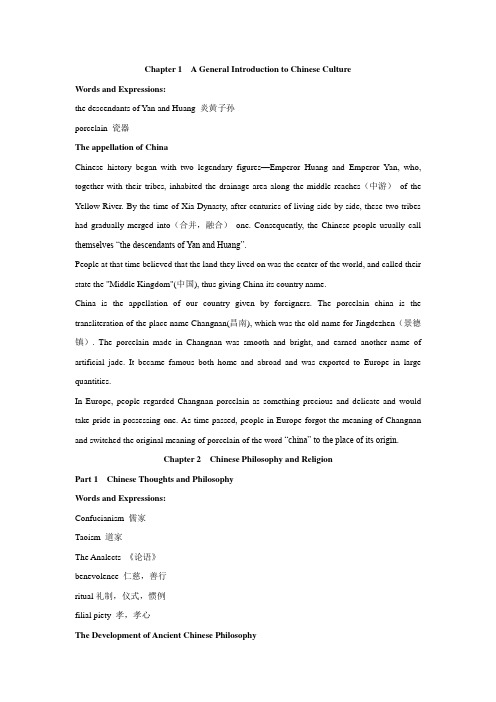
Chapter 1 A General Introduction to Chinese CultureWords and Expressions:the descendants of Yan and Huang 炎黄子孙porcelain 瓷器The appellation of ChinaChinese history began with two legendary figures—Emperor Huang and Emperor Yan, who, together with their tribes, inhabited the drainage area along the middle reaches(中游)of the Yellow River. By the time of Xia Dynasty, after centuries of living side by side, these two tribes had gradually merged into(合并,融合)one. Consequently, the Chinese people usually call themselves “the descendants of Yan and Huang”.People at that time believed that the land they lived on was the center of the world, and called their state the "Middle Kingdom"(中国), thus giving China its country name.China is the appellation of our country given by foreigners. The porcelain china is the transliteration of the place name Changnan(昌南), which was the old name for Jingdezhen(景德镇). The porcelain made in Changnan was smooth and bright, and earned another name of artificial jade. It became famous both home and abroad and was exported to Europe in large quantities.In Europe, people regarded Changnan porcelain as something precious and delicate and would take pride in possessing one. As time passed, people in Europe forgot the meaning of Changnan and switched the original meaning of porcelain of the word “china” to the place of its origin.Chapter 2 Chinese Philosophy and ReligionPart 1 Chinese Thoughts and PhilosophyWords and Expressions:Confucianism 儒家Taoism 道家The Analects 《论语》benevolence 仁慈,善行ritual礼制,仪式,惯例filial piety 孝,孝心The Development of Ancient Chinese PhilosophyThe philosophy in Pre-Qin times (先秦子学)The orthodox philosophy during the Han Dynasty (两汉经学)Metaphysics during the Wei and Jin dynasties (魏晋玄学)The buddhist philosophy during the Sui and Tang dynasties (隋唐佛学)Neo-confucianism in Song and Ming dynasties (宋明理学)Application philosophy in the Ming and Qing dynasties (明清实学)The philosophy in Pre-Qin times (先秦子学)The philosophy in Pre-Qin times was marked by the emergence of various ancient philosophical views.The most influential schools were Confucianism (儒家), Taoism (道家), Mohism (墨家) and Legalism (法家)1.ConfucianismConfucianism is a school of thought represented by Confucius and Mencius. Confucianism has influenced the Chinese for thousands of years and is deeply rooted in Chinese culture. It is an integration of intellectual, political, and religious tradition with the focus on the individual morality and ethics in daily life and the proper exercise of political power.Who is Confucius?Family name: Kong; Given name: Qiu; courtesy name: ZhongniHe is a great thinker, an educator, a statesman, a philosopher, the founder of the Confucian school and Confucianism.The landmark of Confucianism is the Analects, which was written by his disciples after his death. The core of Confucius’s philosophy are the concepts ofRen (benevolence)Ren(仁): Confucius defines it as “Airen”(爱人),that is , to love others.The Chinese character “仁”(benevolence) consists of “a person (人)” on the left and “two(二)” on the right indicating the relationship between people.Li (ritual)Li (ritual-礼)refers to the rules of human conduct and moral norms such as politeness, courtesy, propriety, proper etiquette and good manners ranging from speech and behavior to the performance of rituals which are usually codified and treated as an all-embracing system of socialnorms.Xiao (filial piety)Xiao(孝)refers to the filial piety, which was regarded as one of the greatest of virtues in Chinese tradition, denoting the respect and obedience that the children should show to their parents. Zhong (loyalty)Zhong(loyalty-忠)is a great virtue, which emphasizes the obligations and duties to the superior, to friends, family, and spouse.2. TaoismFounded by Lao Zi and Zhuang Zi, the school advocates the doctrine that the Dao is the course, the principle, the substance, and the standard of all things, to which all of them must conform. Based on the work of Dao De Jing, Taoism promotes the belief that a person should live a simple life, not to strive for wealth, fame or power, which will only give one worries and trouble. The school favours the political principle of “achieving good government through non-action”(无为而治)3. MohismBase on the teaching of Mozi, the school cherishes universal love which states that if all the people in the world loved one another, there will be no hatred, calamities, and hostilities.In politics and ethics, Mohism proposes honoring virtuous people, opposing fatalism (宿命论) and aggressive wars, and upholding thriftiness(节俭).4. LegalismLegalism, begun by Hanfeizi, espouses (主张) laying down laws to unify the thought of people, promoting agriculture to achieve affluence (富裕), waging (进行) wars to gain strength and power, and establishing a system of bureaucracy (官僚制度).The orthodox philosophy during the Han Dynasty (两汉经学)In the Han Dynasty, Emperor Wudi instituted the campaign of “banning all schools of thought except Confucianism(罢黜百家,独尊儒术)”. He chose officials from th ose who were steeped in Confucianism only. Consequently, Confucianism became an orthodox school that served as the ideological foundation of the feudal rule throughout the dynasties in China.Traditional Chinese ethicsTraditional Chinese ethics includes both good and bad elements. Some reflect the high standard ofmoral pursuit of the Chinese people, while others seem less relevant in modern society. For example, the three obediences and four virtues (三从四德) and the three basic rules and five constant virtues (三纲五常) have long been abandoned by the Chinese people.The traditional ideal of a woman is that she is a dependant being whose behavior is governed by “three obediences” (to father before marriage, to husband after marriage, and to son after becoming a widow: 未嫁从父, 既嫁从夫, 夫死从子) and four “virtues” (morality, pro per speech, modest manner, and diligence: 品德、言语、仪态、女工).These were the social norms prescribed by feudal morality.The three basic rules: a king should rule over his subjects; a father, his son; a husband, his wife (君为臣纲、父为子纲、夫为妻纲).The five constant virtues: benevolence, righteousness, propriety, wisdom, and fidelity (仁、义、礼、智、信).Part 2 Religions and BeliefsWords and Expressions:Heaven worship 祭天Ancestor worship 祭祖Confucianism 儒教The Confucian Temple 孔庙Taoism 道教The Five Elements 五行Buddhism 佛教Buddha 佛像,佛祖,佛陀nirvana涅盘Heaven worshipThe heaven worship was the bureaucratic(官僚的) belief system adopted by most dynasties of China until the overthrow(推翻) of the Qing Dynasty.Heaven was believed to manifest itself through the powers of the weather and natural disasters. Heaven was seen as a judge of humans.The emperors are Sons of Heaven(天子), and their power are authorized by heaven. Such beliefs actually consolidated(巩固) the authority of the Emperor.Ancestor worshipChinese worship of ancestors dates back to the prehistory. Chinese culture, Confucianism, and Chinese Buddhism all value filial piety as a top virtue, and the act is a continued display of piety and respect towards departed ancestors.Confucianism儒教Confucianism is not a real religion, it is just an ethical(伦理道德的) and philosophical system, which developed from?Confucius’ thoughts and later was treated as a kind of belief to educate common people(教化大众).The Taoist ReligionA General Introduction of TaoismTaoism is the indigenous (土生土长的) religion in China.The Taoist religion evolved out of witchcraft (巫术), necromancy(方术) and self-cultivation techniques. Its highest belief is called “Dao”, its bible is called “Dao De Jing”. It had great impact on the thinking of the Chinese people, as well as on the political, economic and cultural life of the country.BeliefsYin-yang TheoryYin-yang are opposing, Yin-yang are mutually rooted, Yin-yang mutually transform, Yin-yang mutually wax and waneThe Five Elements/Wuxing“五行”The relationship between the five elements:The Generating CycleWood feeds Fire; Fire creates Earth; Earth bears Metal; Metal carries Water; Water nourishes Wood.The Overcoming CycleWood parts Earth; Earth absorbs Water; Water quenches Fire; Fire melts Metal; Metal chops Wood.BuddhismBuddhism is the most important religion in China. It is generally believed that it was spread to China in 67 AD during the Han Dynasty (206 BC-220) from Hotan(和田)in Xinjiang to Central China. During its development in China, it has a profound (深远的)influence on traditionalChinese culture and thoughts, and has become one of the most important religions in China at that time.Its Deity is Sakyamuni(释迦牟尼);Its doctrine is based on transmigration(轮回).What is the fundamental cause of all suffering?Desire!What did the Buddha teach?The doctrine of Four Noble Truths (四谛)⏹life is suffering,⏹the cause of suffering is desire,⏹the answer is to quench (抑制) desire,⏹the way to this end is to follow the Eight-Fold Path (八正道).What do Buddhists believe?Nirvana is a peaceful, detached state of mind.Achieving Nirvana means escape from the cycle of rebirth.Buddhism in China has developed into three sections, namely the Han, Tibetan and Southern Buddhism.Chapter 3 Chinese Characters, Calligraphy and PaintingWords and Expressions:Chinese Characters 汉字calligraphy书法calligrapher书法家Oracle bone script甲骨文The regular Script 楷书Four Treasures of the Study 文房四宝brush 毛笔ink stick 墨ink stone 砚台The origin of the Chinese characters1.Keep records by tying knots (结绳说)2.The Eight Diagrams (八卦说)3.Cang Jie created the characters(仓颉造字说)The evolution of Chinese characters font(汉字的字体演变)Oracle bone scriptIt refers to incised(雕刻的) ancient Chinese characters found on oracle bones, which are animal bones or turtle shells used in divination(预言) in ancient China.Bronze ware script金文It refers to characters found engraved on bronze vessels, utensils, weapons etc.The Seal Characters (篆书)Soft lines of strokes and upright rectangular shape keep the seal form characters more close to pictography (象形文字). Each of the characters has a balanced and symmetrical (对称的) pattern. The Official Script(隶书)It was the turning point in the evolution of Chinese scripts and is the foundation of the later script forms. It turned the remaining curved and round strokes of the seal form into linear (直线的) and flat square (扁方形) shapes.The regular Script (楷书)It is still today’s standard writ ing. It is square in form, and non-cursive in strokes.The running Script (行书)The running form is somewhere between the regular and the cursive forms allowing simpler and faster writing.The Cursive/Grass Character(草书)This style of calligraphy is smooth and lively with strokes flowing and characters linking together.The characters are often joined, with the last stroke of one merging into the initial stroke of the next. It is executed freely and rapidly so that parts of the characters appear exaggerated (夸张的).CalligraphyPlaying musical instruments, playing chess, calligraphy and painting were considered as the four essential skills for a learned scholar.The Chinese saying “The handwriting reveals the person” (字如其人), is directly related to calligraphy.Four Treasures of the Study 文房四宝brush毛笔ink stick墨paper 纸ink stone砚Famous Chinese Calligraphers in HistoryWang Xizhi —the sage of Chinese calligraphyZhang Xu (张旭)——the “sage of the cursive hand””草圣”Yan Zhenqing——the four greatest masters of Regular script.Liu Gongquan——a master of Regular Script and Running-cursive(行草)PaintingPaintingChinese Traditional Painting refers to ink - wash painting (水墨画) .Traditional Chinese paintings are not “purely” paintings. T hey combine fine art, poetry, calligraphy, and seal engraving to achieve an artistic unison (一致). Human figures, landscapes, flowers, birds, and pavilions are the most important themes of traditional Chinese painting.The classification of Chinese paintingAccording to subject matterFigure paintingLandscape paintingBird-and-flower paintingAccording to the techniqueThe xie yi schoolThe gong bi schoolChapter 4 LiteratureWords and ExpressionsCelestial Poet (诗仙)Saint Poet (诗圣)Romance of the Three Kingdoms 《三国演义》Water Margin《水浒传》Journey to the West《西游记》Dream of the Red Mansions《红楼梦》The Tang PoemThe Tang Dynasty saw the continued development of Chinese poetry. The Complete Anthology of Tang Poems (《全唐诗》), edited in the early Qing Dynasty, is the biggest-ever collection of Chinese poetry. It contains 48,977 poems by 2,208 poets who wrote in different styles.The development of poetry in the Tang Dynasty can be classified into four stages, namely Early Tang, High Tang, Mid Tang, and Late Tang (初唐,盛唐,中唐,晚唐)Early TangThe Four Literary Eminences(初唐四杰)Wang Bo, Yang Jiong, Luo Binwang, and Lu ZhaolinHigh TangA whole generation of literary giants appeared during the High Tang period when society enjoyed prosperity and stability. Li Bai and Du Fu are regarded as the twin master poets of the Tang Dynasty.Li Bai,the “Celestial Poet (诗仙)”, has long been regarded the greatest romantic poet in Chinese literature. In his poems, imagination, exaggeration, diction and sonorous rhythms are blended effortlessly.Du Fu, the “Saint Poet (诗圣)”, has been considered as the greatest realistic poet in Chinese literature. A mirror of the times, his poems faithfully and profoundly reflect the social realities of Tang Dynasty in decline, like a poetic historical account. Because he reached perfection in developing a depressing literary style, his works have been considered as the classics of realism. The other poets in this period can be grouped into two categories: frontier poets (边塞诗人)represented by Gao Shi and Cen Shen, and pastoral poets (田园诗人)represented by Meng Haoran and Wang Wei.Mid-TangThe outstanding poet Bai Juyi succeeded Du Fu with poems reflecting the reality of society.Late TangWith the deterioration of the government in the late Tang Dynasty, the poems reflected, more and more, the hopeless and helpless feelings of the people. Poets turned to the theme of nostalgia (怀旧) for the former splendor (辉煌)of old times. The most talented of these were Li Shangyin and Du Mu, who were often called “Young Li Bai and Du Fu”.Fiction in the Ming and Qing DynastyIn the Song Dynasty, huaben (话本), the earliest novels written in colloquial language started to appear. By the Ming and Qing dynasties, novels grew rapidly as a lively and free literary form. The language of the novels was simple, easy to understand, and welcomed by the public.Four famous Chinese classical novelsRomance of the Three Kingdoms 《三国演义》Water Margin《水浒传》Journey to the West《西游记》Dream of the Red Mansions《红楼梦》Winner of the Noble Prize in Literature, Mo YanOn 11 October 2012, the Swedish Academy announced that Mo Yan had received the Nobel Prize in Literature for his work . Aged 57 at the time of the announcement, he was the 109th recipient of the award and the first ever resident of mainland China to receive it .Mo Yan has written 11 novels, and several novellas and short story collections.《红高粱家族》Red Sorghum, 《天堂蒜薹之歌》The Garlic Ballads, 《十三步》Thirteen Step,《食草家族》The Herbivorous Family, 《丰乳肥臀》Big Breasts and Wide Hips, 《酒国》The Republic of Wine: A Novel,《红树林》Red Forest, 《檀香刑》Sandalwood Death, 《生死疲劳》Life and Death Are Wearing Me Out, 《四十一炮》Pow!, 《蛙》FrogChapter 5 EducationWords and ExpressionsPrivate Schools私塾Official Schools官学the Four Books and the Five Classics四书五经Imperial Examination 科举Nine-year Compulsory Education 九年制义务教育V ocational Education 职业教育College Entrance Examination 高考Bachelor’s degree学士学位Master’s degree 硕士学位Doctor’s degree 博士学位Confucius Institute孔子学院Private SchoolsA private school refers to a school set up by a family, clan, or teacher that generally had just one teacher who gave individual tuition, and that had no set textbooks and no specified time span of study.In the Spring and Autumn Period, private schools prevailed and many scholars of different schoolsof thought spread their teaching in this way. Among them, the private school run by Confucius was the largest and most influential.Confucius’ private school:3000ciples(弟子); 72 virtuous and talented studentsConfucius’ educational ideas:“Education should be for all, irrespective of their social status.”(有教无类)“Six arts”: ritual, music, archery, chariot-riding, writing, and arithmetic.(六艺:礼、乐、射、御、书、数)Official SchoolsOfficial schools began during the Western Zhou Dynasty, and were sponsored by the official constitution called Xiangxue .Only children of nobles were admitted.The teaching materials were centered on the Four Books and the Five Classics(四书五经). Imperial Examination System (科举)Imperial Examination System in China began in the Sui Dynasty and lasted more than 1,300 years until the last examination was held during the Qing Dynasty.It was conducted at two levels: xiangshi(乡试) and huishi(会试)During the Ming and Qing Dynasty, the examination was designed to select jinshi(进士). It featured writing ,which involved the writing of an Eight-part Essay(八股文).After the Opium War in 1840 with the spread of the Western ideology and technology in China , it was under attack by people. It was abolished in 1905.Nine-year Compulsory EducationThe law of compulsory education came into effect on July 1, 1986, requiring each child to have nine years of formal education.China’s Nine-year Compulsory Education is composed of two parts: six-years in primary school and three-years in junior high school.In 1989, China launched two ambitious projects: Project Hope (希望工程) and the Spring Bud Project (春蕾计划) These two projects have helped children, especially girls, in poor areas to attend schools.The National College Entrance Examination is an academic examination held annually in China aimed to select high-school graduates for college admissions.Higher EducationMore than two thousand universities, colleges, and institutes in China offer four or five-year programs. Students who have earned Bachelor of Arts or Science degrees may apply for Master of Arts or Science programs and then three-year Doctor of Philosophy (Ph.D.) programs. Confucius InstituteConfucius Institute is not a general sense of the university, but the promotion and dissemination (传播)of Chinese culture and Chinese language education.Chapter 6 Dress and Adornment CultureWords and Expressionsattire/ costume/trappings 服装、服饰The Silk Road 丝绸之路The Maritime Silk Road海上丝绸之路embroidery/im‘br?id?ri /刺绣;刺绣品Li Brocade 黎锦The Intangible Cultural Heritage 非物质文化遗产China has many ethnic groups with a long history. For thousands of years, generations of clothing designers have devoted themselves to building the Kingdom of Clothes, making the garments that cover the human body into an important component of Chinese culture.Cheong-sam(Qi Pao)Cheong-sam came from Qizhuang of manchu women’s costume. The cheongsam is easy and comfortable to wear, snugly fitting the female Chinese figure. Its neckline is high, collar closed, and its sleeves may be short, med ium or full length, depending on the season or the wearer’s taste. The dress is buttoned on the right side, with a loose bodice, a fitted waist, and side-slits to the hem, all of which combine to set off the beauty of the female’s figure.Chinese tunic suit (Zhongshan suit /Mao suit)The modern Chinese tunic suit is a style of male attire known in China as the Zhongshan suit, and known in the West as the Mao suit (after Mao Zedong). Sun Zhongshan introduced the style shortly after the founding of the Republic of China as a form of national dress although with a distinctly political and later governmental implication.Tang CostumesA tang costumes (literally: "Chinese suit" ) is a Chinese jacket that originated at the end of the Qing Dynasty. The tangzhuang evolved from the magua (Chinese: 马褂), which the Han Chinese were forced to wear it during the Qing Dynasty. In modern times it has been adopted by common people. They are often worn by men, although women wear them as well.In Chinese communities, the Zhongshan suit, the western suit, and the Tang suit are the main forms of formal dress for men on many occasions.The Silk RoadThe Silk Road refers to the ancient trade route connecting Asia Continent and European Continent, usually it can be classified into Northern Silk Road on the land, and the Maritime Silk Road. Embroidery (刺绣)Embroidery is a traditional Chinese handicraft featuring flowers, birds and scenery on silk or other cloth in colored silk threads. Chinese embroidery dates back over 3,000 years. It has distinct regional and ethnic characteristics.Embroidery in China includes:Shu Embroidery (蜀绣) from Sichuan,Su Embroidery (苏绣) from SuzhouSu embroidery enjoys a good reputation of the first of the Top-four embroidery in China.Xiang Embroidery (湘绣) from HunanYue Embroidery (粤绣) from Guangdong.Li BrocadeAcclaimed as a "living fossil" of Chinese textiles, the Li-style brocade was chosen in the first batch of items for the Intangible Cultural Heritage list released by UNESCO in 2009. The Li brocade has been part of China's national cultural heritage, but as few people nowadays have the skills necessary to weave the special brocades, the practice is in danger of becoming extinct.Chapter 7 Part 1Food CultureWords and Expressionsfoodie 吃货culinary厨房的,烹饪的;烹调用的cuisine烹饪,烹调法;菜肴main food主食,主粮(staple food )aroma芳香,香味seasonings调味品、调料A general introduction of Chinese foodChinese cuisine(菜肴)is widely seen as representing one of the richest and most diverseculinary(烹饪的) cuisines and heritages in the world.A meal in Chinese culture is typically seen as consisting of two or more general components: Zhushi (main food)---typically rice, noodles, or mantou (steamed bun), and accompanying dishes of vegetables, meat, fish, or other items, known as cai (dish) in the Chinese language. This cultural conceptualization is in some ways in contrast to cuisines of Northern Europe and the USA, where meat or animal protein(蛋白质) is often considered the main food(主食).Chinese cuisine is a complete presence of color, aroma(芳香,香味) and taste. (色香味俱全)In China, we have eight branches of cuisine.Shandong Cuisine山东菜系(鲁菜)Guangdong Cuisine广东菜系(粤菜)Sichuan Cuisine四川菜系(川菜)Hunan Cuisine湖南菜系(湘菜)Jiangsu Cuisine淮扬菜系(苏菜)Zhejiang Cuisine浙江菜系(浙菜)Fujian Cuisine福建菜系(闽菜)Anhui Cuisine安徽菜系(徽菜)Hainan CuisineHainan is noted for its "Four Best Known Dishes" -- Wenchang Chicken, Jiaji Duck, Dongshan Mutton东山羊and Hele Crab和乐蟹.Chapter 7 Part 2 Tea and Wine CultureA Brief Introduction to Tea CultureTea (茶) commonly denotes the drink made from steeping(浸泡)the processed leaves, buds(芽), or twigs of the tea bush (茶树) in water.On both casual and formal Chinese occasions, tea is consumed regularly. In addition to being a drink, Chinese tea is used in Traditional Chinese medicine and in Chinese cuisine.It is universally acknowledged that China is the original tea-growing area, as well as the firstcountry to grow, produce and drink tea.At the end of the sixteenth century, the Dutch(荷兰人) brought word to Europe that there was a kind of magic leaf in the east, from which tasty drinks could be made, and this was the first time that Europeans heard of tea.In 1610, the East India Company(东印度公司) was the first to sell tea to Europe, after which the habit of drinking tea took root there. Britain is famous for its tea drinking.The Classifications of Chinese TeaGreen tea绿茶Black tea红茶Oolong tea乌龙茶Yellow tea黄茶White tea 白茶Scented tea花茶Compressed tea砖茶Unique customs of taking tea in different regions:Guangdong Morning teaFujian Kongfu teaSichuan “Covered-bowl tea”Tibetan Buttered tea(酥油茶)Inner Mongolia Milk teaHainan Laoba TeaHainan Laoba Tea“Laoba tea”(La oba means father) is a special scene in Haikou, a pot of tea with some snacks, people sit around an old table,for killing time and strengthening the relationship with theirs friends, it hasn’t the limitation of time or place. Most of places of traditional Laoba tea are barely furnished, the prices of food and tea there are cheap. The teahouse of Laoba tea is a little world of society, a mirror of the traditional life in Hainan.The Functions of Offering TeaTo show respectTo apologizeTo express thanks to the elders on one’s wedding dayTea EtiquetteServing a cup of tea is more than mere politeness.When offered tea, it is considered polite to at least take a sip.When you pour tea, the rule of “full cup for wine and half cup for tea”should be observed. Chinese Wine CultureThe Origin of Chinese WineChinese wine, as a special form of culture, has a history of more than five thousand years . Chinese wine making can be traced back as far as 4000 BC, to the early period of the Neolithic Yangshao Culture (新石器时代的仰韶文化). During its long development, Chinese wine has developed distinctive characteristics.Types of Chinese WineHuangjiu (yellow rice wine)Huangjiu is one of three dominated brewed wines (beer and grape wine) in the world. Huang Jiu predates all the other liquors, with a history of several thousand years. Among these liquors the Shaoxing Rice Wine is the most famous.Baijiu(white wine)Being made from sorghum, corn, barley or wheatFruit WineFermented alcoholic beverages made from a variety of base ingredients (other than grapes); May also have additional flavors taken from fruits, flowers, and herbs.Red WineA type of wine made from dark-coloured (black) grape varieties. The actual colour of the wine can range from intense violet, typical of young wines, through to brick red for mature wines and brown for older red wines.BeerToast etiquetteChinese Drinking Etiquette(礼仪)The Chinese people care more about the people we drink with.That is Chinese drinking etiquette reflects the respect of the drinkersThe host and guests have their own seat and order of toast(敬酒顺序)When toast,the host come first,and firstly,they should toast the most honored guest.The wine vessel must be full.The younger should toast the elder and drink all of the wine.(先干为敬)Western Drinking EtiquetteThe drinking etiquette of west show the respect of wine.To distinguish wine we need to watch its color, smell its fragrance, taste its taste(观其色、闻其香、品其味). They drink for enjoying, so sometimes they drink themselves. They do not encourage others to drink, neither do they consider letting other drunk is a way to show their etiquette.Chapter 4 Traditional Festivals and CustomsWords and ExpressionsLegal holiday/ official holiday 法定节假日Solar calendar阳历Lunar calendar 阴历/ Agricultural calendar 农历Spring Festival (春节)Lantern Festival (元宵节)Tomb-sweeping Festival/ Qing Ming Festival (清明节)Dragon Boat Festival(端午节)Mid-autumn Festival (中秋节)Double Ninth Festival (重阳节)Intangible Cultural Heritage非物质文化遗产Spring Festival (春节)China’s most important festival falls on the 1st day of the 1st lunar month each year. Family members gather just as they do for Christmas in the West.CustomsSpring CleaningWrite and paste couplets(对联) on doorsSet off fireworksReceive Gift MoneyGreet each otherLantern Festival (元宵节)The Lantern Festival, celebrated on the 15th day of the first lunar month, is closely related to the Spring Festival. It marks the end of the New Year celebrations, following which life returns to normal. The most prominent activity of the Lantern Festival is the grand display of beautiful。
中国文化概论-2024鲜版

使用规范
遵循国家语言文字工作委员会发布的《现代汉语通 用字表》、《普通话异读词审音表》等规范标准, 注意避免使用生僻字和异体字,正确使用标点符号 等。
2024/3/27
12
03
哲学思想与宗教信仰自由政策
Chapter
2024/3/27
13
儒家思想体系及其影响
2024/3/27
儒家思想的核心观念
仁、义、礼、智、信等。
经典剧目欣赏
各剧种都有其经典剧目,如京剧《穆 桂英挂帅》、豫剧《花木兰》、越剧 《红楼梦》等。
21
传统美术创作理念和代表作品
传统美术创作理念
注重意境的表现和情感的传达,追求笔墨的韵味和画面的诗意。
代表作品
中国传统美术作品丰富多样,如山水画、花鸟画、人物画等,代表作品有《清明上河图》、《富春山居图》等。
天文图谱与星表 古代中国天文学家编制了多种天文图谱和星表,如《石氏 星表》、《步天歌》等,为天文研究提供了重要资料。
26
医学理论体系构建及治疗方法探讨
中医理论体系
中医以阴阳五行学说为 基础,构建了独特的医 学理论体系,包括脏腑 经络学说、病因病机学 说、诊法治则学说等。
2024/3/27
中药与方剂
地域性
中国文化具有鲜明的地域特色,不同地域的文化在饮食、建筑、 艺术等方面表现出多样性。
民族性
中国文化是多元一体的,由56个民族共同创造,各民族的文化 相互交融、相互影响。
包容性
中国文化具有强大的包容性,能够吸收和融合外来文化,形成独 特的文化景观。
5
历史传承与发展脉络
历史传承
中国文化具有悠久的历史传承,自古至今,文化传承从未中断,形成了独特的文化传统。
中国文化概况 复习资料

Chapter 1The Origin of Chinese Culture文化词汇Confucian philosophy 儒家哲学Confucius孔子Mencius孟子the descendants of Y an and Huang 炎黄子孙the Spring and Autumn and the Warring States Periods 春秋战国时期The Art of War《孙子兵法》porcelain 瓷器三皇五帝Three Emperors and Five Sovereigns)Gregorian calendar/ solar calendar格里高利历,是国际通用的历法,即公历lunar calendar阴历the Twenty-four Solar Terms二十四节气Chinese Zodiac生肖Chinese Culture---Past and PresentChinese history began with two legendary figures—Emperor Huang and Emperor Yan, who, together with their tribes, inhabited the drainage area along the middle reaches(中游)of the Yellow River. By the time of Xia Dynasty, after centuries of living side by side, these two tribes had gradually merged into(合并,融合)one. Consequently, the Chinese people usually call themselves “the descendants of Yan and Huang”.People at that time believed that the land they lived on was the center of the world, and called their state the "Middle Kingdom"(中国), thus giving China its country name.Traditional Chinese culture is recorded not only in history books and documents, but also in archeological records(考古记载), such as ancient city walls, palaces(宫殿), temples(寺庙), pagodas(宝塔), and grottos(洞窟); artifacts(史前古器物), such as bronze objects, weapons, bronze mirrors, coins, jade and pottery objects, and curios; and folk culture, including song and dance, embroidery(刺绣), cuisine(烹饪), clothing, tea ceremonies, drinking games, lanterns, riddles, martial arts(武术), chess and kites. With a continuous history of 5,000 years, it has undergone frequent transformations to produce a rich and vital cultural heritage.In the modern day, with the rise of western economic and military power beginning in the mid-19th century, Western systems of social and political organization have gained adherents in China. Indeed, within today’s globalized environment, modern cultures interact and cooperate increasingly more with each other. China’s culture of the future will most likely reflect this cross-cultural dimension. Thus, obtaining a solid understa nding of China’s culture of the past is necessary in order to successfully embrace all that the culture has to offer to the world.The Appellation of ChinaChina is the appellation of our country given by foreigners. The porcelain china is the transliteration of the place name Changnan(昌南), which was the old name for Jingdezhen(景德镇). The porcelain made in Changnan was smooth and bright, and earned another name of artificial jade. It became famous both home and abroad and was exported to Europe in large quantities.As time passed, people in Europe forgot the meaning of Changnan and switched the original meaning of porcelain of the word “china” to the place of its origin.The Alternative Names of China⏹Chixian, Shenzhou(赤县、神州)⏹Jiuzhou (九州)⏹Hua ( 华)⏹Huaxia(华夏)⏹Zhonghua(中华)⏹Hainei(海内)Chinese MythologyChinese Mythology is a collection of cultural history, folktales(民间故事), and religions that have been passed down in oral or written form. Chinese mythology is similar to modern religion in that they both believe in relationships between mankind and a higher power.Historians have conjectured(推测)that Chinese mythology began in 12th century BC (close to the time of the Trojan War 特洛伊战争). The myths and legends were passed down in oral form for over a thousand years, before being written down in early book such as Shui Jing Zhu and Shan Hai Jing.The classification of myth神话的分类Creation myth 创世神话:Nvwa Created Man(女娲造人)Hero myth 英雄神话:Houyi Shooting the Sun(后羿射日)War myth 战争神话:Yellow Emperor Tackled Human-God(黄帝擒蚩尤)Cultural MosaicHeavenly Stems and Earthly BranchesThe standard Gregorian calendar is generally referred to as the solar calendar in China. The traditional Chinese lunar calendar, also known as the Jiazi calendar, counts the years in sixty-year cycles by combining two series of numbers---the 10 Heavenly Stems and 12 Earthly Branches.The Twenty-four Solar TermsThe traditional Chinese lunar year is divided into twenty-four solar terms, according to the position of the sun on the ecliptic in relationship to the earth. The solar terms designate agricultural periods, and can predict changing seasonal conditions, temperature, and weather throughout the course of the year. They are extremely important to agricultural production.Changes in the four seasons are determined by eight solar terms:立春( the Beginning of Spring),春分( the Spring Equinox ),立夏(the Beginning of Summer ),夏至(the Summer Solstice),立秋(the Beginning of Autumn),秋分( the Autumnal Equinox),立冬( the Beginning of Winter),冬至(the Winter Solstice )Changes in temperature are indicated by five solar terms:小暑Slight Heat ,大暑Great Heat ,处暑the Limit of Heat ,小寒Slight Cold ,大寒Great ColdChanging weather conditions are indicated by seven solar terms:雨水Rain Water ,谷雨Grain Rain ,白露White Dew ,寒露Cold Dew,霜降Frost's Descent ,小雪Slight Snow ,大雪Great Snow .Recurring natural phenomena are indicated by four solar terms:惊蛰the Waking of Insects ,清明Pure Brightness ,小满Grain Full,芒种Grain in EarChinese ZodiacIn ancient times, our ancestors counted the years with 10 heavenly stems and 12 earthly branches. Although this was scientific, most people were illiterate and could not memorize or calculate easily. Thus the animals that influenced people's lives were chosen to symbolize the terrestrial branches: the rat, ox, tiger, rabbit, dragon, snake, horse, sheep, monkey , rooster, dog and pig.Chapter 2 Culinary Culture文化词汇culinary厨房的,烹饪的;烹调用的cuisine烹饪,烹调法;菜肴main food主食,主粮(staple food )Fire temperature火候food tonic 食补“Food is the first necessity of the people”(“民以食为天。
中国文化概况A Glimpse of Chinese Culture(修订版)Chapter 8

10
Features of Chinese Food
Yin-yang Principle Each food has its own characteristics of yin or yang.
Yin foods : thin, cold ,low calories. Boiling makes food yin. Yang foods : rich, spicy, hot ,high calories. Frying makes food yang.
9
Features of Chinese Food
Seasonings
taste mainly depends on the seasonings. many tastes—salty (salt, soy sauce), sweet (sugar, honey), sour (vinegar), fragrant (sesame oil, coriander, wine), spicy(chilli, garlic, ginger), tangy(monosodium glutamate or MSG), bitter(dried tangerine, bitter apricot kernel),etc.
Lead-in Activity
Chinese diet
Discussion & Presentation
6
Culinary Culture
Features of Chinese Food
Eight Regional Chinese Delicacy Table Manners
Cuisines A Bite of China
中国文化概况中英版
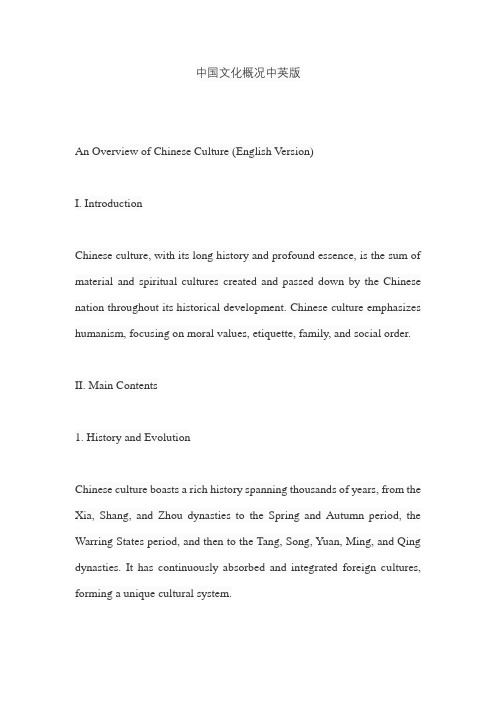
中国文化概况中英版An Overview of Chinese Culture (English Version)I. IntroductionChinese culture, with its long history and profound essence, is the sum of material and spiritual cultures created and passed down by the Chinese nation throughout its historical development. Chinese culture emphasizes humanism, focusing on moral values, etiquette, family, and social order.II. Main Contents1. History and EvolutionChinese culture boasts a rich history spanning thousands of years, from the Xia, Shang, and Zhou dynasties to the Spring and Autumn period, the Warring States period, and then to the Tang, Song, Yuan, Ming, and Qing dynasties. It has continuously absorbed and integrated foreign cultures, forming a unique cultural system.2. Traditional ValuesConfucianism is one of the cornerstones of Chinese culture, emphasizing virtues such as benevolence, filial piety, loyalty, and etiquette, which have profoundly influenced the behavior and values of the Chinese people. Taoism emphasizes the harmony between man and nature, advocating a natural and non-interventionist approach. Buddhism, on the other hand, emphasizes compassion and self-sacrifice, having a significant impact on Chinese religion and philosophy.3. Cultural Characteristics- Festival Culture: China has many traditional festivals, such as the Spring Festival, Mid-Autumn Festival, and Dragon Boat Festival, each with unique celebration methods and cultural connotations.- Clothing Culture: Traditional Chinese clothing, such as Hanfu and Tangzhuang, reflects the unique aesthetic concepts and cultural characteristics of the Chinese nation.- Architectural Culture: Traditional Chinese architecture, including palaces, temples, and gardens, is renowned for its distinctive styles and exquisite craftsmanship.- Cuisine Culture: Chinese cuisine, known for its rich flavors and exquisiteculinary techniques, is an important representation of China's cultural charm.4. Influence on the WorldThe values and ideological systems of Chinese culture have had a profound impact on the world, especially Confucianism, which has influenced Asia and beyond. Traditional Chinese arts and forms of expression, such as calligraphy, painting, and Peking Opera, are also deeply loved and admired by people around the world.III. ConclusionChinese culture is a treasure of the Chinese nation, embodying unique charm and value. Through learning and understanding Chinese culture, we can gain a deeper understanding of the history, traditions, and spiritual outlook of the Chinese people, further enhancing our sense of national pride and self-confidence. At the same time, Chinese culture has also made significant contributions to the diversity and development of world culture.中国文化概况中英版一、引言中国文化,源远流长,博大精深,是中华民族在长期历史发展过程中所创造并传承下来的物质文化和精神文化的总和。
《中国文化概况 英汉对照版 》读书笔记PPT模板思维导图下载

Culinary Cult...
3 三 建筑文化
Architectur e
4 四 行在中国
Tr a v e l i n g in ...
5 课后练习题
Practice
(二)唐装 Tang Costume
(一)汉服 Hanfu
(三)旗袍 Cheongsam
01
(一)筷 子 Chopsti cks
(一)回族 Hui Ethnic Gro...
(三)回族与维 吾尔族的关系 The Re...
第十一章 中国的创造 Chinese C...
一 四大发明 1
Four Great In...
二 大国重器 2
The Pillars o...
3 三 新四大发
明 Four New Gre...
4 四 “黑科技”
06 第六章 中国的政治制 度 Chinese ...
目录
07 第七章 中国人的生活 Chinese D...
09 第九章 中国的国粹 Chinese Qu...
08 第八章 中国的节日 Chinese Fe...
010
第十章 中国的少数民 族 Ethnic M...
目录
011 第十一章 中国的创造 Chinese C...
三 中国人的业余 生活 The Spare...
课后练习题 Practice
(二)从“独生 子女”政策到 “二孩”政策
的...
(一)中国婚礼 Chinese Wedd...
(三)中国人的 餐桌文化 Chinese ...
(二)微信 WeChat
(一)5G生活 5G Life
(三)支付宝 Alipay
大学中国文化概况英语教材
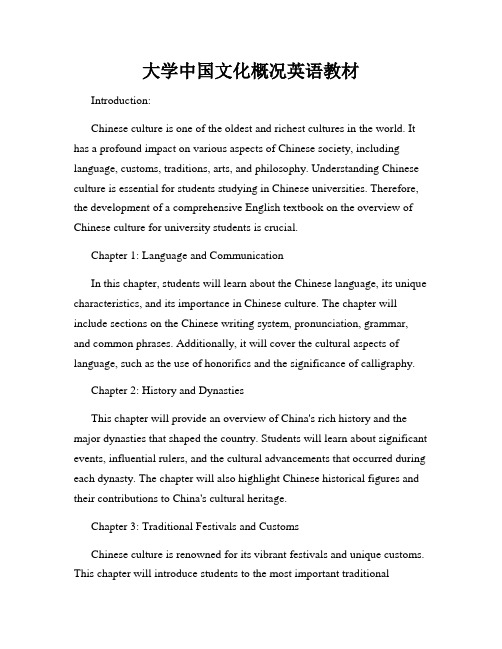
大学中国文化概况英语教材Introduction:Chinese culture is one of the oldest and richest cultures in the world. It has a profound impact on various aspects of Chinese society, including language, customs, traditions, arts, and philosophy. Understanding Chinese culture is essential for students studying in Chinese universities. Therefore, the development of a comprehensive English textbook on the overview of Chinese culture for university students is crucial.Chapter 1: Language and CommunicationIn this chapter, students will learn about the Chinese language, its unique characteristics, and its importance in Chinese culture. The chapter will include sections on the Chinese writing system, pronunciation, grammar, and common phrases. Additionally, it will cover the cultural aspects of language, such as the use of honorifics and the significance of calligraphy.Chapter 2: History and DynastiesThis chapter will provide an overview of China's rich history and the major dynasties that shaped the country. Students will learn about significant events, influential rulers, and the cultural advancements that occurred during each dynasty. The chapter will also highlight Chinese historical figures and their contributions to China's cultural heritage.Chapter 3: Traditional Festivals and CustomsChinese culture is renowned for its vibrant festivals and unique customs. This chapter will introduce students to the most important traditionalfestivals, including the Spring Festival (Chinese New Year), Mid-Autumn Festival, and Dragon Boat Festival. The customs associated with these festivals, such as lion and dragon dances, lantern riddles, and mooncake making, will be explained in detail.Chapter 4: Philosophy and ReligionChinese philosophy and religion have greatly influenced Chinese culture and society. This chapter will explore concepts such as Confucianism, Taoism, and Buddhism, as well as their impact on ethics, social relationships, and personal development. Students will gain an understanding of the moral and spiritual aspects of Chinese culture through studying these philosophical and religious traditions.Chapter 5: Traditional Arts and CraftsChinese culture boasts a rich artistic heritage, including traditional arts and crafts forms such as calligraphy, painting, porcelain, and silk. This chapter will provide an introduction to these art forms, their history, techniques, and cultural significance. Students will also have the opportunity to learn about famous Chinese artists and visit renowned cultural sites.Chapter 6: Food and CuisineChinese cuisine is renowned worldwide for its diversity, flavors, and culinary techniques. This chapter will introduce students to the key elements of Chinese cuisine, regional specialties, and dining etiquette. Students will also learn about the cultural importance of food in Chinese society, such as the role of food in celebrations and social gatherings.Conclusion:A comprehensive English textbook on the overview of Chinese culture for university students will provide them with essential knowledge and understanding of China's rich cultural heritage. Through studying language, history, festivals, philosophy, arts, and cuisine, students will gain a deeper appreciation for Chinese culture and be better equipped to navigate and engage with Chinese society and its people.。
外教社2024中国概况(修订版)第七章 PPT课件(试用版)07 第七章 语言文字 V1
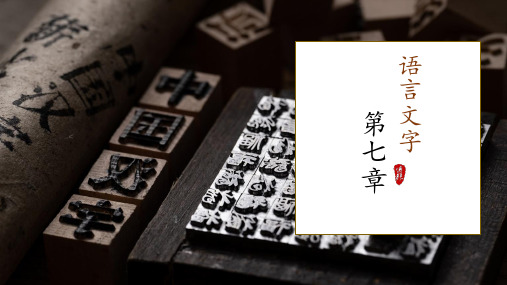
日月明,小大尖,土也地,鱼羊鲜,木子李,舌甘甜
三、汉字的六书
形声
“合体造字法”
形声字由形旁和声旁两部分组成,
“形旁表示字义,声旁表示字音”。
沐
齿
现代汉字中形声字占了90%以上, 并且直到现在仍然能够创造新字。
三、汉字的六书
汉字是以象形字为基础,以形声字为主体的 表意文字系统。
汉字约有几万个,其中最常用的是3000个左右。
象形字来自于图画文字,是一种最早最古老的造字方法。
三、汉字的六书
指事
“独体造字法”
大多数指事字在象形的基础上, 加上有抽象意义的符号,表示别 的意思。
刀
刃
木
本
三、汉字的六书
会意
“合体造字法”
“休”:是一个人在树下, 表示休息的意思。
会意字由两个或多个独体字组成, 两部分的形状和意思合起来表达 这个字的意思。
字母文字
• 字母文字都是从左到右 线性书写;
• 英语、法语是表音文字;
汉字
• 汉字是一个个的方块, 由各个部分组合而成。
• 汉语是表意文字;
三、汉字的六书
象形
会意
假借
指事
形声 汉字的六书
转注
三、汉字的六书
象形
“独体造字法”
日
用文字的线条或笔画,把事物的
月
外形、特点具体地画出来。
三、汉字的六书 鱼 门
语
言
第 七
文 字
章
CONTENTS
目录
文第
三
字节
语第
二
言节
基中 第
本国 情语
一 节
况言
文
字
的
中 国
- 1、下载文档前请自行甄别文档内容的完整性,平台不提供额外的编辑、内容补充、找答案等附加服务。
- 2、"仅部分预览"的文档,不可在线预览部分如存在完整性等问题,可反馈申请退款(可完整预览的文档不适用该条件!)。
- 3、如文档侵犯您的权益,请联系客服反馈,我们会尽快为您处理(人工客服工作时间:9:00-18:30)。
26
Danu Festival
• Yao’s New year • lasts four days from the 26th of the fifth lunar month • activities include: dancing the bronze drum dance, doing antiphonal singing, and joking in drinking
flame red color scare off the monster first day of the first lunar month
flee to the mountains
grandma beggar
11
Spring Festival
• On the 8th day of the 12th lunar month, laba porridge was made. It contains all kinds of beans. • On the 23rd day of the 12th lunar month, sacrifices are offered to the Kitchen God. Now, people make delicious food to enjoy themselves. • decorations are prepared before Spring Festival • a sumptuous family dinner is served on the Spring Festival eve
7
Major Traditional Festivals
Spring Festival
Lantern Festival
Qingming Festival
Dragon Boat Festival
Double Seventh Festival
Mid-Autumn Festival Double Ninth Festival
• Chinese Valentine’s Day • originates from the story of Niu Lang and Zhi Nv
18
d-Autumn Festival
Some famous lines about the festival:
I raised my head, the splendid moon I see; Then droop my head and sink to dreams of my hometown. (举头望明月, 低 头思故乡) My one wish for you, then , is long life; And a share in this loveliness(the moon) far, far away. (但愿人长久, 千里共婵 娟)
16
Dragon Boat Festival
• also called Duanwu Festival • originates from Qu Yuan • zongzi was eaten • dragon boat racing being an indispensable part
17
Double Seventh Festival
A GLIMPSE OF CHINESE CULTURE
中国文化概况
1
Chapter 7 Traditional Festivals
2
学习目标
•介绍中国传统节日; •了解少数民族传统节日; •思考中国传统节日的传承和保护。
3
Overview
Lead-in Activity
Chinese Festivals
13
Lantern Festival
• celebrated on the 15th day of the first lunar month • with a grand display of beautiful lanterns • riddles pasted onto lanterns are guessed • yuanxiao, a kind of rice dumplings, was eaten
8
Spring Festival
What will occur to your mind when you think of Spring festival?
family get-together
lucky money
fire crackers
family reunion dinner
9
Spring Festival
14
Qingming Festival
• a day for mourning the dead • falls on 4---6 April each year • after the festival, the temperature rises and rainfall increases in readiness for spring plowing
Discussion & Presentation
4
Lead-in Activity
Discuss Watch the video and discuss the following questions: 1 What’s the new trend of spending holidays for Chinese people? 2 How do overseas retailers cater to Chinese shoppers?
15
Qingming Festival
• originates from the legend of Jie Zitui • tomb sweeping is an important activity • cold food was prepared the day before • kite flying and playing on the swing were also activities during the festival
25
Torch Festival
• traditional festival of the Yi people and some other ethnic minority groups in southwest China • big, pagoda-shaped pine torches were built • people holding the torches gather together to sing, dance and drink, in hope of having a good harvest next year
24
Nadam Fair
• observed by the Mongolian people • celebrated in August • main events include: horse racing, wrestling, archery and theatrical performances
21
Chinese Festivals
Major Traditional Festivals
Ethnic Minority Festivals
Public Holidays and Traditional Festivals
22
Ethnic Minority Festivals
Water-splashing Festival Nadam Fair Torch Festival Danu Festival
27
Third Month Fair
• festival of the Bai people • lasts from 15th to the 21st of the third lunar month • activities include horse racing, archery, singing, dancing and a commodity fair • also an occasion for love
10
Spring Festival
The legend of spring festival
Use the clues to tell the story.
Nian ferocious devour animals and people villagers firecrackers
New Year’s eve
5
Overview
Lead-in Activity
Chinese Festivals
Discussion & Presentation
6
Chinese Festivals
Major Traditional Festivals
Ethnic Minority Festivals
Public Holidays and Traditional Festivals
28
Antiphonal Singing Day
• a traditional festival for the Zhuang people and some other ethnic minorities • young people, dressed in their best, gather in the fields and do antiphonal singing in groups with those of the opposite sex
